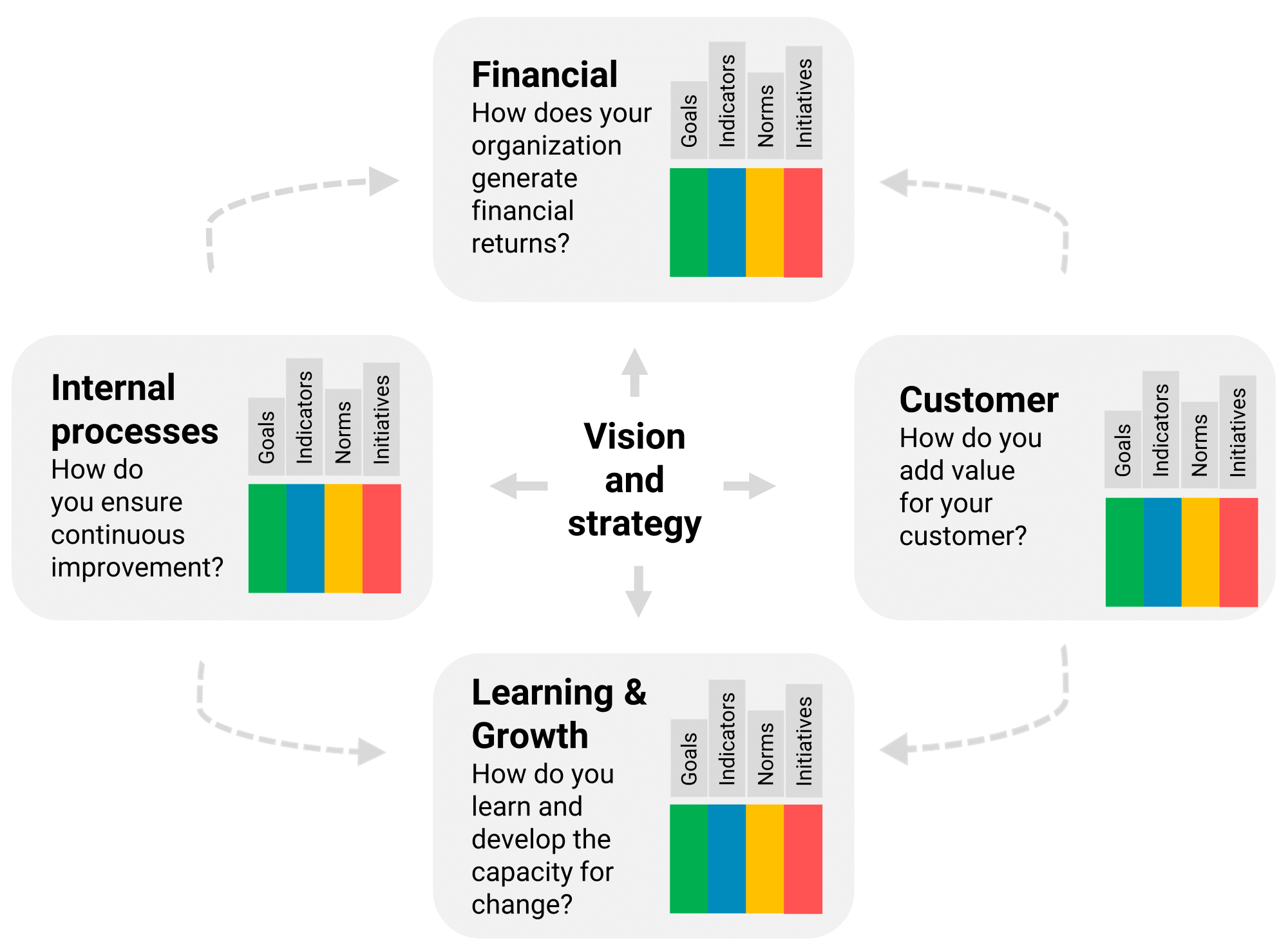What is a Balanced Scorecard?
The Balanced Scorecard is a methodology that allows you to focus the energy, competencies and specific knowledge that your employees possess very specifically on your organization’s long-term strategic goals in a balanced way. That may sound abstract. More concretely, our unambiguous definition of the Balanced Scorecard is as follows:
A Balanced Scorecard (BSC) is a management tool used to measure, manage, and improve an organization’s financial and non-financial performance.
In other words, you are going to translate your strategy into actions and you are going to measure the performance achieved as a result. This is the only way to become a leader with the Balanced Scorecard, according to Kaplan and Norton.
The 4 perspectives of the Balanced Scorecard
The four perspectives below outline the key questions you need to ask and answer to identify your organization’s strategic goals.
- Financial perspective: How do you make your organization financially profitable? In this financial perspective, you set out how you will achieve a healthy margin and financial return. What is crucial in this process? Where are your cash cows?
- Customer and market perspective: How do you add value for your customers? How do your customers experience the added value of the products and services you provide? You make that clear to the customers.
- Internal process perspective: How do you ensure continuous improvement of your processes? For this, you look at waste in your business process, productivity improvements, and hiccups, especially in your primary processes. You incorporate this into the internal processes perspective.
- Learning and growth perspective: How do you remain capable of continuous development and improvement? This involves a combination of soft and hard factors. Think about the development of specific competencies of your people, training and education, and developing a future-proof IT infrastructure.
 Figure 1: The four perspectives of the Balanced Scorecard
Figure 1: The four perspectives of the Balanced Scorecard
The above four perspectives of the Balanced Scorecard create balance between short-term and long-term goals. Well-constructed Balanced Scorecards are characterized by uniform goal orientation because all measurements are aimed at implementing an integrated strategy.
Being more successful with the BSC
To successfully implement and apply the Balanced Scorecard, you must know the advantages and disadvantages. It is precisely because of the disadvantages that problems arise during implementation. Or for that reason, companies just don’t get started. As a result, organizations fail in their strategic initiatives and strategy execution. Therefore, when getting started with the BSC, it is important to know well both sides of using the Balanced Scorecard.
Benefits of the Balanced Scorecard
The BSC is an easy-to-understand concept. You gain insight from four perspectives. With it, you are able to illustrate the causal relationships between those perspectives. Consider the relationships between customers, processes, finance, and learning & growth. This leads to several key benefits.
In addition to these obvious benefits of the Balanced Scorecard, there are additional benefits, or additional arguments for making the business case for BSC seriously. For example, organizations with a BSC are much less affected by hierarchy, abuse of power and political games. They base their decisions on facts and data and rely less on intuition. The value proposition to customers also often looks better.
Disadvantages of the Balanced Scorecard
Apart from the interesting advantages of the BSC, there are certainly also disadvantages. An important indication of this, of course, is the rather high failure rate indicated by several authors. Research shows that it has dropped from roughly 70% to about 55%. Nevertheless, this percentage is still considerable. Therefore, the central conclusion cannot be other than that although the concept appears to be easily transferable, it does not appear to be easily achievable in practice. Consequently, one can easily trace the disadvantages of the BSC to problems that are evoked in realizing implementation conditions.
At first glance, these disadvantages seem like killjoys for the responsible application of the Balanced Scorecard, yet they are certainly not insurmountable. They are merely an additional argument for delving thoroughly into the Balanced Scorecard principles before you start designing the BSC.
Three key elements
The merit of the Balanced Scorecard concept is that it makes the strategic contribution of the performance drivers behind financial results directly visible. Every financially sound company works with it. Successful implementation of a strategy always requires three key elements:
- describing the strategy with a strategy map
- measuring the strategy with unadulterated KPIs
- managing the strategy with dashboards
Note: “unadulterated” or “true” KPIs expressly mean the non-financial performance indicators. While KPIs may have financial implications, they themselves are never financial in nature.
Effective steering & forecasting
A Balanced Scorecard method thus looks beyond purely financial measures and makes steering much more effective. Coherent goals, KPIs, standards and initiatives are optimally aligned in this model. And that’s what makes it so particularly powerful. Furthermore, the Balanced Scorecard effortlessly combines financial metrics with the underlying performance drivers.
All intelligent, data-driven companies and financially healthy organizations work according to the principles of this model. They have thus also discovered that steering on just the financials is no fun at all. Why? Because then you are always running behind the facts. Financial ratios are the result of many pre-existing processes and a combination of all kinds of activities. With the Balanced Scorecard, you can start measuring and especially adjusting earlier in your process. You get more grip and your KPIs provide more predictive value.
It is not surprising that research shows that organizations that invest a lot in learning and growth do much better than others in the long term. Consider innovation as well. They also place primary focus on optimizing internal processes and in increasing added value for the customer. The financial growth will eventually come naturally.
Barriers to implementing the BSC
In addition to the disadvantages mentioned here, we point out some factors that may hinder the use of the balanced scorecard in practice.
- Hyper-competition: When your organization operates in a competitive and rapidly changing market (hyper-competition), it is necessary to be able to adjust or sharpen the strategy frequently. Monitoring the strategy then requires being able to adjust the BSC quickly. The question is whether under these circumstances a relatively inflexible performance management system such as the BSC, is appropriate. Brignall criticizes the imbalance within the BSC with respect to stakeholders. In addition to the customer, employee, and shareholder, Brignall believes there are more stakeholders that should be included in the BSC. Consider the social context and the environment. You don’t normally include these last two components in the BSC. The solution here is to think “out of the box” and add such a perspective.
- Mister Balanced Scorecard: Baraldi and Monolo point out that successfully implementing the concept of BSC requires the sustained commitment of both top and middle management. Without this commitment, you cannot implement the BSC optimally. It is then not going to bear fruit. It is a well-known phenomenon that after launching the BSC, top management’s attention shifts to another top priority rather quickly. The commitment changes. Within some organizations, this shift is accelerated by the fact that the complexity of the BSC has become too great. For this, see also point 5. The risk is so great that the controller, who is assumed to be able to deal with that complexity, then becomes “Mr. BSC”.
- There are no universal success models: In addition to the above advantages and disadvantages, I would also like to make a more methodical remark. This, incidentally, applies to many well-known (standard) models. Management models, such as the BSC, the INK management model, and the value-based scorecard have face validity. At first glance, they offer a lot of guidance. Such models are appealing and inviting. In part, the BSC also falls into this category. It provides a clear framework with 4 perspectives. But the fact that the user is presented with a track record of standard choices can lead to unwanted side effects. When using such standard models, one must therefore take due care.
- Copying or standardizing the balanced scorecard: Convenience, or the need for uniformity quite often lead an organization to largely adopt or copy another organization’s BSC. This leads to time savings in the development process. But this practice can significantly reduce the potential positive impact of the BSC concept. Even if certain organizations, for example, business units, share common characteristics, the basic assumption is that each organizational strategy has unique characteristics. This is precisely what should be taken into account a lot when building the performance management system. Thus, the BSC is a strategic theory – coherence between the four defined perspectives – rather than a standardized strategic tool. People still sometimes overlook this. In short: every organization’s BSC, and every organizational unit’s BSC is unique.
In addition to the obstacles mentioned above that hinder the successful application of the Balanced Scorecard, there are also a number of pitfalls. The distinction between obstacles and pitfalls is not so sharp in practice, but pitfalls can be seen as traits in which you go too far, for example, you formulate far too many KPIs, or you pay too little attention to data literacy as a core competency.
Follow BSC theory, not slavishly but critically
When creating strategy maps and drafting the BSC, it is wise to use Kaplan and Norton’s insights, but not follow them slavishly. This applies to all organizations, not just smaller ones. Constantly consider whether the result does justice to the specific strategic situation of your own organization.
ADVICE: When convenient, don’t be afraid to omit or add elements or perspectives from the Balanced Scorecard. In this way, you guard against the instrument becoming (too) leading, and against formulating wrong objectives that do not reflect the strategy of your organization. Even if they do fit nicely into the Kaplan and Norton recipe.
The 7 biggest pitfalls of a Balanced Scorecard
If you want to be successful with the Balanced Scorecard methodology, be sure to keep in mind some crucial aspects. These are decisive for successful implementation in your organization. Here are the 7 biggest pitfalls to avoid.
- NO PERFORMANCE-DRIVEN CULTURE & PASSION FOR IMPROVEMENT. You want to deliver top performance together with your people. You’re ambitious and customer-focused. But a performance-driven culture requires good preparation, tight discipline, resilience, calm and rhythm, and a real winner’s mentality. Performance management also means continuous improvement: raising the bar a little higher each time and giving your people a good example. Only then will they get moving. If such a performance and improvement culture is lacking, then a Balanced Scorecard and KPIs are of no use to your company. What can you do to get a more performance-driven culture? Start by giving and receiving feedback in your organization or team. Do this regularly and practice it. And start discussing key KPIs with each other, not monthly but weekly, for example. Without judging your people.
- KNOWLEDGE ABOUT CHANGE MANAGEMENT IS LACKING. A Balanced Scorecard process is actually a change process focused on the nerve center of your organization. You’re going to visualize that with strategy maps. And then you collectively find out that the priorities are wrong. You realize that your work is part of a larger whole. You clarify those connections and dependencies. You also discover that the current way of steering and managing is outdated. This requires a different attitude and new behavior from employees and managers. In addition, each person in the organization has their own perception of the course of events. You want to arrive together at a correct business model and a new strategy. Then you definitely need to get people on the same page. So to manage all these changes, you need a lot of practical knowledge of change management. Lacking that, the BSC fails.
- NO URGENCE. The urgency for a Balanced Scorecard should be clear to everyone. Can you properly name what is wrong with the current mode of strategy formation and direction? What will it achieve? The top of the organization must be able to make this clear to everyone. And name its urgency. The sense of urgency is strictly necessary because investing in a Balanced Scorecard can quickly become expensive. Especially when you are ambitious and want to do everything exactly by the book.
- BLIND SPOT FOR DATA. For a Balanced Scorecard process to be successful, you must have a number of competencies and basic skills, such as data literacy, data quality knowledge, spreadsheets, and data-driven work. Lacking these skills and understanding, the BSC gives the wrong picture. Data literacy is the consistent use of data for analysis and action by everyone in the organization. To populate KPIs, you need reliable data. But is the available data accurate, complete, and consistent, and so on? As you continue to develop the Balanced Scorecard, you need assurance of that. Almost all Balanced Scorecards today are cast in a digital format, such as Microsoft Excel and Google Spreadsheets. To make smart use of these, you do need to know the limitations of such templates to avoid mistakes.
- NOT UNIQUE ENOUGH. You can’t copy a strategy from your competitor, even if it seems like a smart move at first glance. It is exactly the same with a Balanced Scorecard. You cannot simply copy it from another company either. The added value of the BSC concept lies precisely in being able to hone your own strategy so finely that after a while no other company can copy your business model. Even if they knew all the details of it. They won’t succeed. This is because your organizational strategy will have become so deeply ingrained in your people, processes, and systems that it has become an organizational competency. And that’s what makes your Balanced Scorecard unique. Which makes it a powerful strategic weapon to stay ahead of your competitors.
- NO BALANCE IN STEERING. The Balanced Scorecard is an excellent tool for balancing your control. In addition, it strengthens the synergy of the various activities (source: Foundations of the Balanced Scorecard). Still, we very often see projects where the emphasis is on the financial perspective. Such an implementation is doomed to fail. In fact, it violates the principles of the Balanced Scorecard. Instead, it is crucial to learn to understand and improve the underlying drivers of your financial performance. To avoid this pitfall, it is better to start at the bottom with the critical success factors in the learning & growth perspective. That’s also where you often find your organization’s original passion and core competencies. From there you then work your way up. Via your internal processes and your customers, you then eventually arrive at the critical success factors for financial growth.
- TOO MANY INDICATORS. After the critical success factors, you start determining the indicators. This way you make your strategy and the critical success factors measurable piece by piece. But you soon discover that you end up with far too many indicators. This is a major pitfall that you can therefore also notice and avoid quite easily. The solution is to test all indicators by checking whether they meet the 7 characteristics of real KPIs. Only the real KPIs will you use to monitor, manage, and refine your strategy. All other indicators you assess for relevance just to be sure. They then get a less prominent place in your Balanced Scorecard and on the dashboard.
Three valuable tips
In relation to creating a BSC, three practical tips apply to making the Balanced Scorecard a success:
- Guard against it becoming “a fill-in-the-blank” exercise. Creativity and brainpower fall away, and that is precisely what is essential in a strategy development process.
- Critically assess the normativity of Kaplan and Norton’s statements. After all, you don’t always know if the statements are relevant or applicable in the given situation.
- Realize that there are no universal models of success.
It is always a matter of customization. You must always keep your own distinctiveness in mind. This is the only way to make your own strategy measurable and successful.
Our proven approach to scorecarding
Our comprehensive approach to the Balanced Scorecard is characterized by focus, simplicity and decisiveness. And of course, we take into account the aforementioned implementation aspects and pitfalls. We work from strategic goals and have knowledge of your sector. Moreover, we are 100% tool-independent.
- Where necessary, we first help you to get your organizational strategy crystal clear at various levels. So that there is no more noise in your business model.
- Then we make the strategy clear in the form of a strategy map containing the critical success factors and genuine KPIs.
- Then we help you with the further interpretation of the scorecards: goals, measurements, standards, and initiatives. We do this per organizational unit.
- This gives everyone room to participate. And so everyone is aware of what their contribution to the strategy and objectives is.
- We automate the filling of the scorecards for you. Otherwise, you are not working efficiently. With a dashboard and, optionally, a solid Business Intelligence solution.
- We coach and facilitate your employees and managers in its practical use. Check out our Data Analytics courses.
In short: our experts in Balanced Scorecarding and KPIs support you in the process described above from A to Z so that you can improve your performance.
Learn more here
Want to know where we get our knowledge about Balanced Scorecarding, among other things? Here are some sources:
Strategic change projects: no sinecure
Finally, a note of perspective. In practice, the skill to successfully implement and manage a strategy is considered much more important than the intrinsic quality of the strategy. Precisely shaping and leading strategic change processes successfully is no easy task. The concept described in this contribution is ‘only’ a tool for this.
The danger exists that the methodical steps of the concept give false security to management. And that it distracts attention from the actual causes behind the failure to successfully achieve strategic goals. Consider inadequate management direction or dysfunctional social processes in the organization. So don’t absolutize the concept of the Balanced Scorecard. Use it as a strategic framework to arrive at your own strategic management process.
The 5 pluses of the Balanced Scorecard method
- You get a grip on your SMART goals, you can now align them perfectly
- With one model you can develop, monitor, and manage your strategy
- Your organization becomes more agile and flexible
- Your financial results improve and there is less waste
- You get more satisfied customers and employees
Engage the thought leaders
Do you also want a powerful Balanced Scorecard instead of a paper tiger? Then the BSC consultants of Passionned Group are the right people for you. We have extensive experience in advising and implementing performance management and Balanced Scorecard processes. As “thought leaders”, we wrote a number of books on this fascinating subject. Contact us here for an appointment about the implementation of a crystal clear and widely supported Balanced Scorecard for your organization.
About Passionned Group
 Passionned Group is a specialist in designing and implementing Balanced Scorecards, performance management, and KPIs. Our passionate consultants help larger and smaller organizations in the transition to becoming a smart & performance-driven organization.
Passionned Group is a specialist in designing and implementing Balanced Scorecards, performance management, and KPIs. Our passionate consultants help larger and smaller organizations in the transition to becoming a smart & performance-driven organization. 

 Joint strategy development and performance monitoring provide focus. The BSC creates organization-wide awareness and focus on the critical success factors. Kaplan and Norton speak of the “strategy-focused organization”. They see this as an important, unique selling point of the BSC concept. The value of having focus is that within the entire organization, everyone is aware of a limited number of factors that determine success. Thus, the BSC concept provides direction. This gives people clarity and certainty. Motivation increases when, in addition, employees know why their contributions are needed to implement the strategy. By understanding the
Joint strategy development and performance monitoring provide focus. The BSC creates organization-wide awareness and focus on the critical success factors. Kaplan and Norton speak of the “strategy-focused organization”. They see this as an important, unique selling point of the BSC concept. The value of having focus is that within the entire organization, everyone is aware of a limited number of factors that determine success. Thus, the BSC concept provides direction. This gives people clarity and certainty. Motivation increases when, in addition, employees know why their contributions are needed to implement the strategy. By understanding the  Cause and effect relationships are difficult to determine. With the BSC, there can be “over-complexity” in deriving cause and effect relationships between the critical success factors. In practice, everything is related to everything. Some cause-and-effect relationships between success factors have a clear direction. But a lot of connections are also reciprocal. This makes it difficult to establish unambiguous cause-and-effect relationships. Determining these with a group of managers therefore requires a disciplined and high level of meeting and discussion. Quite often managers do not manage to maintain an overview during mapping sessions. They also find it difficult to select and explain the crucial cause-and-effect relationships between the critical success factors.
Cause and effect relationships are difficult to determine. With the BSC, there can be “over-complexity” in deriving cause and effect relationships between the critical success factors. In practice, everything is related to everything. Some cause-and-effect relationships between success factors have a clear direction. But a lot of connections are also reciprocal. This makes it difficult to establish unambiguous cause-and-effect relationships. Determining these with a group of managers therefore requires a disciplined and high level of meeting and discussion. Quite often managers do not manage to maintain an overview during mapping sessions. They also find it difficult to select and explain the crucial cause-and-effect relationships between the critical success factors.
























